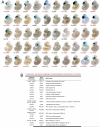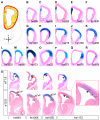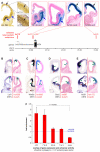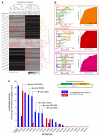A high-resolution enhancer atlas of the developing telencephalon
- PMID: 23375746
- PMCID: PMC3660042
- DOI: 10.1016/j.cell.2012.12.041
A high-resolution enhancer atlas of the developing telencephalon
Abstract
The mammalian telencephalon plays critical roles in cognition, motor function, and emotion. Though many of the genes required for its development have been identified, the distant-acting regulatory sequences orchestrating their in vivo expression are mostly unknown. Here, we describe a digital atlas of in vivo enhancers active in subregions of the developing telencephalon. We identified more than 4,600 candidate embryonic forebrain enhancers and studied the in vivo activity of 329 of these sequences in transgenic mouse embryos. We generated serial sets of histological brain sections for 145 reproducible forebrain enhancers, resulting in a publicly accessible web-based data collection comprising more than 32,000 sections. We also used epigenomic analysis of human and mouse cortex tissue to directly compare the genome-wide enhancer architecture in these species. These data provide a primary resource for investigating gene regulatory mechanisms of telencephalon development and enable studies of the role of distant-acting enhancers in neurodevelopmental disorders.
Copyright © 2013 Elsevier Inc. All rights reserved.
Figures







Comment in
-
Neuroscience: An enhanced view of the brain.Nat Methods. 2013 Apr;10(4):282-3. doi: 10.1038/nmeth.2425. Nat Methods. 2013. PMID: 23653922 No abstract available.
References
-
- Breiman L. Random Forests. Machine Learning. 2001;45:5–32.
-
- Bureau A, Dupuis J, Falls K, Lunetta KL, Hayward B, Keith TP, Van Eerdewegh P. Identifying SNPs predictive of phenotype using random forests. Genet Epidemiol. 2005;28:171–182. - PubMed
Publication types
MeSH terms
Substances
Associated data
- Actions
Grants and funding
- R01 HG003988/HG/NHGRI NIH HHS/United States
- P30 DK063720/DK/NIDDK NIH HHS/United States
- T32 GMO7618/PHS HHS/United States
- R01 NS034661/NS/NINDS NIH HHS/United States
- T32 GM007449/GM/NIGMS NIH HHS/United States
- R01NS062859A/NS/NINDS NIH HHS/United States
- F32 MH081431/MH/NIMH NIH HHS/United States
- R01MH081880/MH/NIMH NIH HHS/United States
- R01NS075998/NS/NINDS NIH HHS/United States
- R37MH049428/MH/NIMH NIH HHS/United States
- R01HG003988/HG/NHGRI NIH HHS/United States
- R01 NS062859/NS/NINDS NIH HHS/United States
- R37 MH049428/MH/NIMH NIH HHS/United States
- R01 MH049428/MH/NIMH NIH HHS/United States
- T32 GM007618/GM/NIGMS NIH HHS/United States
- R01NS34661/NS/NINDS NIH HHS/United States
- R01 NS075998/NS/NINDS NIH HHS/United States
- R01 NS099099/NS/NINDS NIH HHS/United States
- R01 MH081880/MH/NIMH NIH HHS/United States
LinkOut - more resources
Full Text Sources
Other Literature Sources
Molecular Biology Databases

